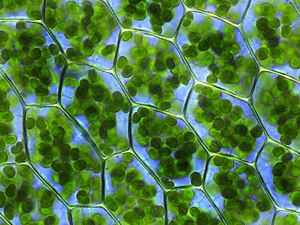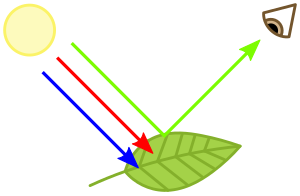
Back Chlorofil Afrikaans Chlorophyll ALS يخضور Arabic كلوروفيل ARY كلوروفيل ARZ Clorofila AST Хлорофилл AV Xlorofil Azerbaijani Хлорофилл Bashkir Хларафіл Byelorussian
Chlorophyll is any of several related green pigments found in cyanobacteria and in the chloroplasts of algae and plants.[2] Its name is derived from the Greek words χλωρός (khloros, "pale green") and φύλλον (phyllon, "leaf").[3] Chlorophyll allows plants to absorb energy from light. Those pigments are involved in oxygenic photosynthesis, as opposed to bacteriochlorophylls, related molecules found only in bacteria and involved in anoxygenic photosynthesis.[4]
Chlorophylls absorb light most strongly in the blue portion of the electromagnetic spectrum as well as the red portion.[5] Conversely, it is a poor absorber of green and near-green portions of the spectrum. Hence chlorophyll-containing tissues appear green because green light, diffusively reflected by structures like cell walls, is less absorbed.[1] Two types of chlorophyll exist in the photosystems of green plants: chlorophyll a and b.[6]
- ^ a b Virtanen O, Constantinidou E, Tyystjärvi E (2020). "Chlorophyll does not reflect green light – how to correct a misconception". Journal of Biological Education. 56 (5): 1–8. doi:10.1080/00219266.2020.1858930.
- ^ May P. "Chlorophyll". University of Bristol.
- ^ "chlorophyll". Online Etymology Dictionary.
- ^ Udayangani S (31 March 2020). "Difference Between Bacteriochlorophyll and Chlorophyll". differencebetween.com.
- ^ Muneer S, Kim EJ, Park JS, Lee JH (March 2014). "Influence of green, red and blue light emitting diodes on multiprotein complex proteins and photosynthetic activity under varying light intensities in lettuce leaves (Lactuca sativa L.)". International Journal of Molecular Sciences. 15 (3): 4657–70. doi:10.3390/ijms15034657. PMC 3975419. PMID 24642884.
- ^ Speer BR (1997). "Photosynthetic Pigments". UCMP Glossary (online). University of California Museum of Paleontology. Retrieved 2010-07-17.



